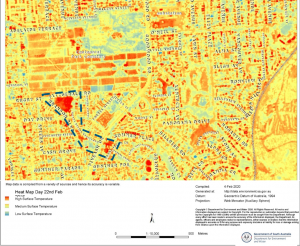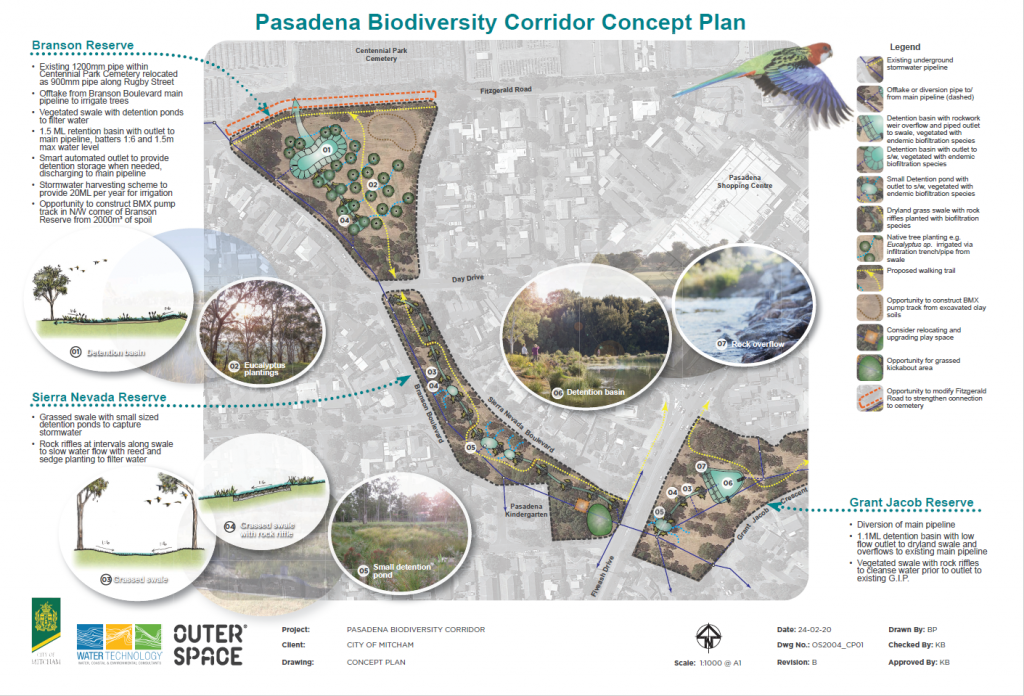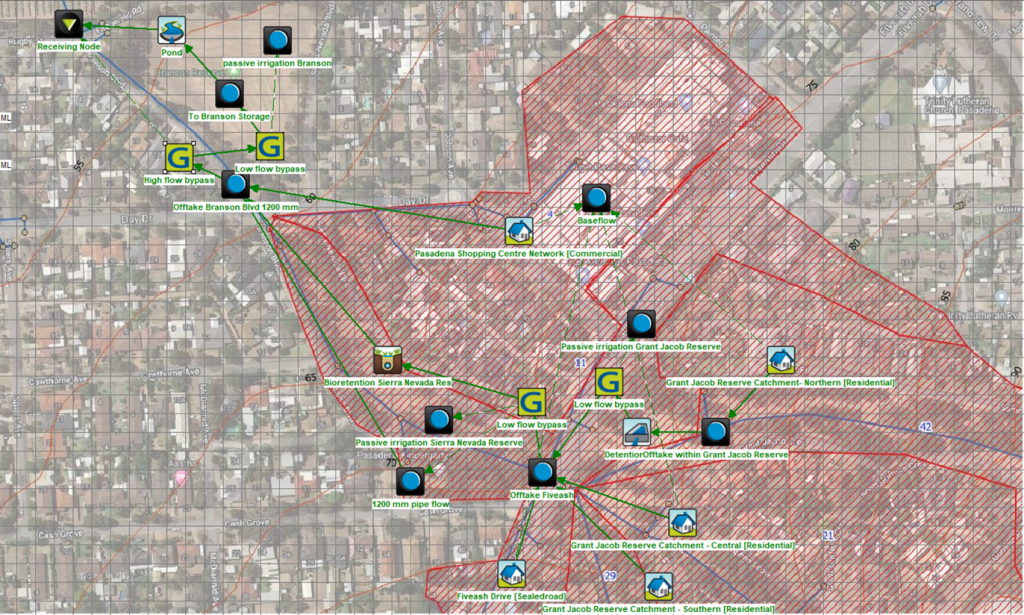Revitalising Adelaide’s drainage reserves
Revitalised Reserves Connecting Communities
Designing a Stormwater System for an Urban Biodiversity Corridor
The drainage reserves that run diagonally through Pasadena from the Adelaide Hills to the Plains are hot, dry and barren.

On an urban heat map (right), the reserves show up as the hottest areas in the locality, scarring the otherwise leafy suburb. Due to open unirrigated bare ground, the reserves contribute more urban heat island impacts than surrounding roads and structures.
The site is near a popular shopping centre, important recreation areas and in an area destined for further urban infill. A radically different passive recreation space is needed to serve the community both now and into the future, and climate change makes quality open spaces rarer.
Revitalising Reserves with a Biodiversity Corridor
Water Technology completed a conceptual design of a multi-function stormwater system for a new Biodiversity Corridor. The stormwater system diverts runoff into a number of underutilised reserves within the City of Mitcham in the Adelaide foothills.
The project revitalises the reserves by providing much-needed water for irrigation and new native tree plantings. This is achieved by daylighting urban stormwater runoff from underground pipes into open channels within the reserves and diverting runoff to infiltration trenches for passive irrigation.
In this way, stormwater management will help deliver multiple benefits, including improving public health, local biodiversity, and providing a green and open space for the local community to reconnect.
eWater MUSIC was a key Water Sensitive Urban Design conceptual design tool used for the project. eWater MUSIC allowed engineers to model multiple stormwater management functions and evaluate the resulting multiple benefits of the Biodiversity Corridor.
The Biodiversity Corridor concept design completed by Water Technology’s engineering consultants included design input from Outerspace Landscape Architects and was carried out in consultation with the City of Mitcham (below).

The design brings stormwater flows from the underground drainage pipes within the reserves to the surface to create a lush, green, passively irrigated recreation space that establishes a biodiversity corridor linking the Adelaide Hills to the Plains.
Developing green space is a focus, with hundreds of new trees and native vegetation understory plantings all sustained by soakage trenches filled by the above-ground creek flows. Increased moisture availability supports healthier canopies with no supplementary watering even in the longest and hottest dry summer, and most of all, lots of shade to draw people to the space to recreate.
Not only will flora and fauna be drawn to the reserves, but also the community as the reserves will become a focal point for residents to visit, walk, run, explore, and engage with nature through the new trails, nature play water areas, benches and BBQ facilities, Kaurna edible garden, and BMX track.
In an area subject to high urban infill, small lot sizes, and minimal canopy cover, the Pasadena Biodiversity Corridor will become a place that brings the community in and allows them to enjoy a cool, vibrant, passive recreation space among native trees, birds, and animals.
Concept Design Features
The concept design provides for daylighting existing stormwater drains within and near several reserves in Pasadena. The design features extensive new native plantings that will be passively irrigated via daylighted stormwater flows conveyed and filtered through a series of raingardens, infiltration trenches and swales. Detention basins are required to attenuate the daylighted flows to offset a future reduction in pipe capacity proposed at a location downstream of the reserves.
As such, a key design requirement for the Biodiversity Corridor was that the stormwater system needed to perform multiple functions delivering multiple benefits.
The functions and benefits included stormwater harvesting for storage and irrigation of reserves and export off-site, low flow diversions for passive irrigation of new tree plantings, and biofiltration basins, ponds and swales to improve water quality.
In addition, the system must distribute low flows equally to the various reserves to keep the new plantings watered consistently.
eWater MUSIC
Including multiple functions and delivering multiple benefits increased the complexity of the stormwater system for the Biodiversity Corridor. Designing and evaluating the system’s performance was a key challenge.
eWater MUSIC was an essential Water Sensitive Urban Design tool for navigating the complexity of the conceptual design of the Biodiversity Corridor (below).

In particular, eWater MUSIC software was used to:
- estimate stormwater runoff volumes from developed areas
- estimate and analyse the sensitivity of stormwater harvesting yield
- estimate low flow volumes available for diversion as passive irrigation
- design biofiltration basins
- assess pond storage inundation frequency
- estimate water quality improvement required for a stormwater harvesting scheme
- estimate the water available for passive irrigation to promote urban cooling.
eWater MUSIC has several unique features that assisted with designing and evaluating Water Sensitive Urban Design approaches in the Biodiversity Corridor. These included:
- Secondary links from nodes allowed low flow diversions to be modelled and optimised.
- Biofiltration, swale and pond treatment nodes allowed treatment of stormwater to a quality fit for harvesting to be modelled.
- Advanced charting within MUSIC allowed rapid assessment of flow frequency at different locations to ensure the system provides equitable distribution of low flows.
- Stormwater harvesting demand patterns and custom demands allowed sensitivity analysis and the viability of a harvesting scheme to be assessed.
eWater MUSIC made a complex stormwater model simple to modify and evaluate. Using eWater MUSIC for conceptual design, ensured that the Biodiversity Corridor has the best opportunity to remain robust, sustainable and functional, and will provide multiple ongoing benefits to the local community.
Next Steps
Following construction, the Biodiversity Corridor will become the ‘jewel in the crown’ for the local suburbs, giving the community access to a lush, cool, green space to walk, explore, recreate, and relax.
The upgrade will improve accessibility for the community by connecting the reserves to the adjacent streets, linking footpaths and trails, and providing all-weather walking surfaces, as well as solar bollard lighting for night safety along the path. Rather than dividing the suburb like a peace wall, the reserves will become a location that integrates the community.
The addition of thousands of new native trees and plants will promote the connection of birds and animals from the Hills Face area to the urban plains, expanding their natural environment. By creating the use of passive stormwater as irrigation, it will create a location that is self-sustaining and climate resilient.
Further Information
For further information on the project please contact Water Technology at the details below.

Water Technology
Dr Michael Di Matteo
michael.dimatteo@watertech.com.au
Phone: (08) 8378 8000
1/98 Greenhill Road, EASTWOOD SA 5063
Ben Taylor

Water Technology
ben.taylor@watertech.com.au
National Practice Lead – Urban Water
Phone: (08) 8378 8000
1/98 Greenhill Road, EASTWOOD SA 5063
